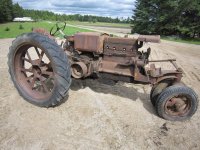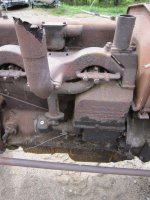Whether your tractor that you run kerosene in requires spark plugs depends on what type of ignition it uses. If it's a compression ignition engine, then it will run on kerosene without plugs. If it's spark ignition, then by definition you need spark plugs. I think a lot of people are only familiar with spark ignition engines that can burn "tractor fuel" so assume that to burn kerosene, the engine must be spark ignition, but any diesel engine will run on kerosene. Whether one should or not for an extended time depends on the blend and the fuel injection system. Then there are turbines which will run on almost anything including kerosene (which is what they're almost always fueled with) and they do have "spark plugs" although the nerds will insist on calling them igniters.
You are using an out of date browser. It may not display this or other websites correctly.
You should upgrade or use an alternative browser.
You should upgrade or use an alternative browser.
Kerosene tractors- spark plugs?
- Thread starter SmallChange
- Start date
- Views: 5270
More options
Who Replied?
/ Kerosene tractors- spark plugs?
#21
Bentrim
Gold Member
- Joined
- Apr 22, 2020
- Messages
- 338
- Location
- York County, Pennsylvania
- Tractor
- Massey Ferguson 245, Massey Ferguson 14 Allis Chalmers G
While you are at it take a look at these engines

 www.theautopian.com
www.theautopian.com
 en.wikipedia.org
en.wikipedia.org

How The US Military's 'Multifuel' Truck Engines Ran On Diesel and Gasoline - The Autopian
Diesel is a great fuel if you’ve got a diesel engine. Put gasoline in, though, and you’ll risk wrecking it to some greater or lesser degree. That is, unless, you had a magical “multifuel” engine that could run on both fuels. Well, it’s not magical, because — on some vehicles like the legendary...
Multi fuel burning motors
Last night I was watching an episode of Junk Yard Empire and featured on this show was the partial restoration of an old fire truck. The truck was a 1940’s Rio Diamond with a partial engine. The yard just happened to have a motor sitting on the property. They said the Rio Diamond Motor was from...
garage.grumpysperformance.com
Stratified charge engine - Wikipedia
dicktill
Gold Member
Well excuse me, I am one of those nerds. The igniter/ignitor is just used to start the combustion process. Once the process starts it is self-sustaining.<snip> Then there are turbines which will run on almost anything including kerosene (which is what they're almost always fueled with) and they do have "spark plugs" although the nerds will insist on calling them igniters.
MHarryE
Elite Member
- Joined
- Feb 15, 2009
- Messages
- 2,972
- Location
- Northeastern Minnesota
- Tractor
- Kubota M7-171, M5-111, SVL75-2, RTV900XT & GR2120; CaseIH 1680 combine
Earlier I mentioned my 1928 Case CC starting on gasoline and switching to kerosene. Here are pictures of the tractor after I recovered it from the trees. The fuel tank has 2 inlets - one in the middle for kerosene and if you look at the rear of the tank, a second portion with the slanted filler for gasoline. The second picture is a close-up of the intake showing the exhaust manifold partly incorporated with the air cleaner to clean and heat the air before exiting to the carb. I can't tell you about the lever and wire going to the carb area - this tractor was parked in the trees long before I was old enough to drive tractor. I learned on a 1951 Farmall Super A. The engine still turns over but radiator and magneto have been robbed. But this gives an idea of what it took to run on distillate as a main fuel.
Attachments
1Mech
Gold Member
- Joined
- Sep 20, 2022
- Messages
- 369
- Location
- Sand Springs, OK & Yellville, AR
- Tractor
- International B414
Sounds like a labor intensive way to run a tractor!Back in the early days of tractors most were made to be able to run"tractor fuel" as it was referred to, now we call it kerosene. Some manufactuers referred to the as "all Fuel" Why? it was only a few cents a gallon and was cheaper than gasolline.
For the manufacturers to make a tractor run on kerosene they had to do a few thngs. Lower the compression to avoid knock, install two fuel tanks, a large one for kerosene and a small usually a gallon or so. Some even used water injection to prevent knock.
To run a tractor on Tractor fuel first you open the valve for gasoline to fill the carburetor, start the engine leave it warm up, close the gasoline valve and open the tractor fuel valve. Now you are ready to work.
To shut off the tractor you turned off the tractor fuel valve and allowed the engine to use the fuel in the carburetor. Next time you went to start the tractor you would be able to start it on gasoline, most would not cold start on kerosene. Even then if you shut it offon kerosene there was usually a drain on the carburetor bowl to drin the tractor fuel.
During the fifties most owners just filled the tractor fuel tank with gasoline and did not bother with the tractor fuel. Even most farmers converted the engine to gasoline only. Diesel was also being introduced and became popular about the same time.
Why use tractor fuel? price and sometimes was easier to get than gasoline.
Disadvantages of tractor fuel -- Less power than a strictly gasoline engine.
John Deere 60 - compression Drawbar horsepower all 321 ci
Gasoline 6 to 1 35.86
All Fuel 4.7 to1 29.17
LP Gas 7.3 to1 37.68
John Deere 70-- CI compression Drawbar horsepower
Gasoline 379.5 6.15 to1 42.24
All fuel 412.5 4.6 to 1 39.58
LP Gas 379.5 7.3 to 1 45.16
Diesel 375.6 16 to 1 45.09
Note cubic inch displacement for all fuel, gasoline, LP and diesel
Reference www.tractordata.com
1Mech
Gold Member
- Joined
- Sep 20, 2022
- Messages
- 369
- Location
- Sand Springs, OK & Yellville, AR
- Tractor
- International B414
As I recall, some of the early heavy equipment such as dozers were diesel, but used a gasoline "pony" engine to turn over the diesel engine.
Williy
Elite Member
- Joined
- Apr 26, 2020
- Messages
- 3,625
- Location
- Texas
- Tractor
- Yanmar YT 235C Yannar YRC 60 rotary cutter, Yanmar RT72 rotary tiller B75 Backhoe & bucket & thumb, LS land grader
Spark plug info:
Iridium spark plugs are the best choice. Their superior materials and construction support the high energy demands of high-performance engines and ensure the cleanest and most efficient combustion. This results in improved acceleration, better fuel efficiency, and the longest lifespan among spark plug types.
willy
Iridium spark plugs are the best choice. Their superior materials and construction support the high energy demands of high-performance engines and ensure the cleanest and most efficient combustion. This results in improved acceleration, better fuel efficiency, and the longest lifespan among spark plug types.
willy
Grendahl
New member
- Joined
- Feb 14, 2025
- Messages
- 8
- Location
- Syracuse, NY
- Tractor
- 2001 JD 4300, 1975 Cat 910, 1952 Case DC-4
Spark ignition engines that ran on kerosene or "tractor fuel" typically had a lower compression ratio head than the same engine designed for gasoline only. Many also had adjustable shutters on the radiator so that the tractor would warm up faster and allow the operator to adjust as necessary to maintain the operating temperature. When running on kerosene, the fuel was more likely to work past the piston rings and dilute the oil. Some tractors had multiple oil level plugs in the sump to drain off the fuel. The thinner kerosene would tend to sit on top of the motor oil in the sump. Each morning the operator would remove the lower level plug to drain off the kerosene, and then refill with new motor oil up to the upper level plug. Quite a bit of extra work was necessary to run the lower cost fuel. The Case CC tractor picture that MHarryE posted above has the multiple oil level plugs in the pan visible on the right side of the engine. That tractor is very similar to my Case DC tractor, although mine has the higher compression "gasoline only" head and no radiator shutters.
Caterpillar diesels of the 1940s used a gasoline pony engine to start the diesel, as you describe.As I recall, some of the early heavy equipment such as dozers were diesel, but used a gasoline "pony" engine to turn over the diesel engine.
International diesels of the same era had a small chamber on each main cylinder that was opened by a valve to reduce the compression ratio and expose the sparkplug so the main engine could start on gasoline, as has been mentioned in earlier posts in this thread.
I don't know about other brands.

